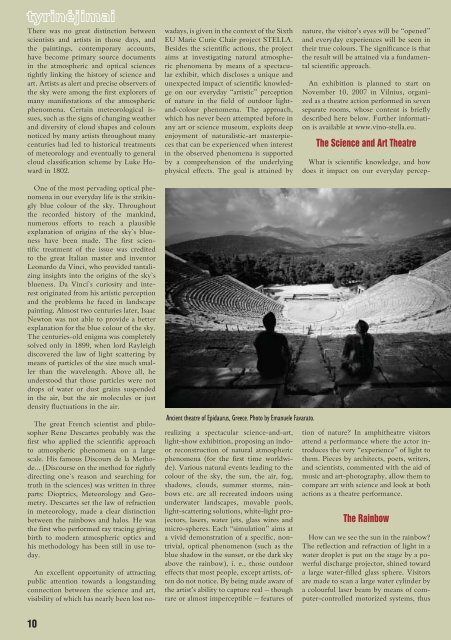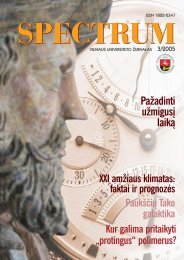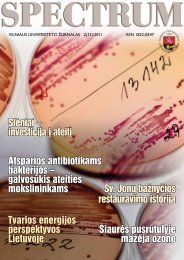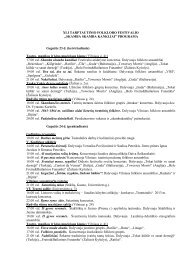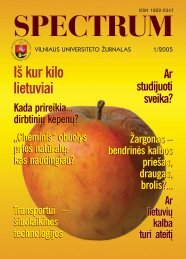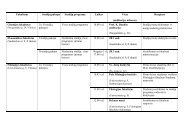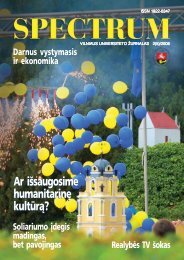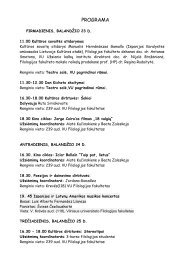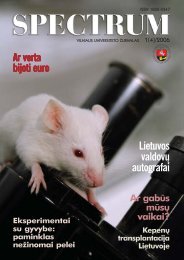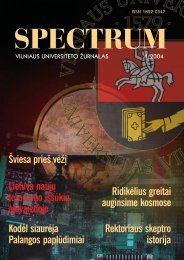Spectrum Nr. 2(7)/2007 - VU naujienos - Vilniaus universitetas
Spectrum Nr. 2(7)/2007 - VU naujienos - Vilniaus universitetas
Spectrum Nr. 2(7)/2007 - VU naujienos - Vilniaus universitetas
You also want an ePaper? Increase the reach of your titles
YUMPU automatically turns print PDFs into web optimized ePapers that Google loves.
tyrinėjimaiThere was no great distinction betweenscientists and artists in those days, andthe paintings, contemporary accounts,have become primary source documentsin the atmospheric and optical sciencestightly linking the history of science andart. Artists as alert and precise observers ofthe sky were among the first explorers ofmany manifestations of the atmosphericphenomena. Certain meteorological issues,such as the signs of changing weatherand diversity of cloud shapes and coloursnoticed by many artists throughout manycenturies had led to historical treatmentsof meteorology and eventually to generalcloud classification scheme by Luke Howardin 1802.An excellent opportunity of attractingpublic attention towards a longstandingconnection between the science and art,visibility of which has nearly been lost nowadays,is given in the context of the SixthEU Marie Curie Chair project STELLA.Besides the scientific actions, the projectaims at investigating natural atmosphericphenomena by means of a spectacularexhibit, which discloses a unique andunexpected impact of scientific knowledgeon our everyday “artistic” perceptionof nature in the field of outdoor lightand-colourphenomena. The approach,which has never been attempted before inany art or science museum, exploits deepenjoyment of naturalistic-art masterpiecesthat can be experienced when interestin the observed phenomena is supportedby a comprehension of the underlyingphysical effects. The goal is attained bynature, the visitor’s eyes will be “opened”and everyday experiences will be seen intheir true colours. The significance is thatthe result will be attained via a fundamentalscientific approach.An exhibition is planned to start onNovember 10, <strong>2007</strong> in Vilnius, organizedas a theatre action performed in sevenseparate rooms, whose content is brieflydescribed here below. Further informationis available at www.vino-stella.eu.The Science and Art TheatreOne of the most pervading optical phenomenain our everyday life is the strikinglyblue colour of the sky. Throughoutthe recorded history of the mankind,numerous efforts to reach a plausibleexplanation of origins of the sky`s bluenesshave been made. The first scientifictreatment of the issue was creditedto the great Italian master and inventorLeonardo da Vinci, who provided tantalizinginsights into the origins of the sky`sblueness. Da Vinci`s curiosity and interestoriginated from his artistic perceptionand the problems he faced in landscapepainting. Almost two centuries later, IsaacNewton was not able to provide a betterexplanation for the blue colour of the sky.The centuries-old enigma was completelysolved only in 1899, when lord Rayleighdiscovered the law of light scattering bymeans of particles of the size much smallerthan the wavelength. Above all, heunderstood that those particles were notdrops of water or dust grains suspendedin the air, but the air molecules or justdensity fluctuations in the air.The great French scientist and philosopherRene Descartes probably was thefirst who applied the scientific approachto atmospheric phenomena on a largescale. His famous Discours de la Methode…(Discourse on the method for rightlydirecting one`s reason and searching fortruth in the sciences) was written in threeparts: Dioptrics, Meteorology and Geometry.Descartes set the law of refractionin meteorology, made a clear distinctionbetween the rainbows and halos. He wasthe first who performed ray tracing givingbirth to modern atmospheric optics andhis methodology has been still in use today.Ancient theatre of Epidaurus, Greece. Photo by Emanuele Favarato.What is scientific knowledge, and howdoes it impact on our everyday perceprealizinga spectacular science-and-art,light-show exhibition, proposing an indoorreconstruction of natural atmosphericphenomena (for the first time worldwide).Various natural events leading to thecolour of the sky, the sun, the air, fog,shadows, clouds, summer storms, rainbowsetc. are all recreated indoors usingunderwater landscapes, movable pools,light-scattering solutions, white-light projectors,lasers, water jets, glass wires andmicro-spheres. Each “simulation” aims ata vivid demonstration of a specific, nontrivial,optical phenomenon (such as theblue shadow in the sunset, or the dark skyabove the rainbow), i. e., those outdooreffects that most people, except artists, oftendo not notice. By being made aware ofthe artist’s ability to capture real – thoughrare or almost imperceptible – features oftion of nature? In amphitheatre visitorsattend a performance where the actor introducesthe very “experience” of light tothem. Pieces by architects, poets, writers,and scientists, commented with the aid ofmusic and art-photography, allow them tocompare art with science and look at bothactions as a theatre performance.The RainbowHow can we see the sun in the rainbow?The reflection and refraction of light in awater droplet is put on the stage by a powerfuldischarge projector, shined towarda large water-filled glass sphere. Visitorsare made to scan a large water cylinder bya colourful laser beam by means of computer-controlledmotorized systems, thus10


